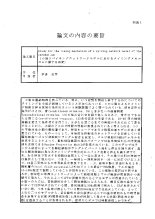Study for the timing mechanism of a spiking network model of the cerebellum 小脳スパイキングネットワークモデルにおけるタイミングメカニズムに関する研究
この論文にアクセスする
この論文をさがす
著者
書誌事項
- タイトル
-
Study for the timing mechanism of a spiking network model of the cerebellum
- タイトル別名
-
小脳スパイキングネットワークモデルにおけるタイミングメカニズムに関する研究
- 著者名
-
本多, 武尊
- 著者別名
-
ホンダ, タケル
- 学位授与大学
-
電気通信大学
- 取得学位
-
博士 (工学)
- 学位授与番号
-
甲第643号
- 学位授与年月日
-
2011-06-30
注記・抄録
博士論文
2011
We built a spiking network model of the cerebellar granular layer and analyzed its dynamics.Assuming N-methyl-D-aspartate (NMDA) channels on the dendrites of model Golgi cells, we found that the voltage-dependent synaptic transmission through the channels controlled the transition of activity states of model granule cells. That is, when input stimulito granule cells were weak, the granule cells synchronously fired at around 9Hz (Synchronized oscillation state); when input stimuli were strong, they exhibited random alternations between burst and silent modes. The population of spiking granule cells changed gradually with time, and did not appear more than once. Because there was no recurrence in the generated sequence, the sequence of populations represented the passage of time (POT) (POT-representing state). Taken together, it is suggested that the dynamics of the cerebellar granular layer is controlled by the strength of mossy fiber input. Furthermore, it was possible to speed up/slow down the sequence generation as the strength of input stimuli increases/decreases in POT-representing state. This is because a time constant of NMDA channels on Goc dendrites was changed with strength of input stimuli by the voltage-dependence of the NMDA channels. When the voltage-dependence was blocked, it was impossible to change the clock speed. Therefore, it is suggested that the speed of the sequence generated from the cerebellar granular layer is controlled by the strength of mossy fiber input. Finally, we performed simulations of delay eyeblink conditioning in the representation of POT between onsets of conditioned and unconditioned stimuli. We added a model Purkinje cell and inhibitory cell (stellate cell or basket cell) to the present model and simulated long-term depression and potentiation at parallel fiber-Purkinje cell synapses and parallel fiber-inhibitory cell synapses. We observed that the PC successfully learned to stop firing at the onset of the unconditioned stimulus and the timing of the stop changed by the strength of mossy fiber input. This suggests that the timing of the condition response is controlled by the strength of mossy fiber input in delay eyelid conditioning. Thus, this phenomenon may be generated by a network include the cerebellar granular layer.
